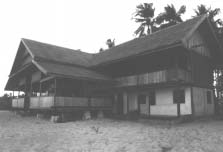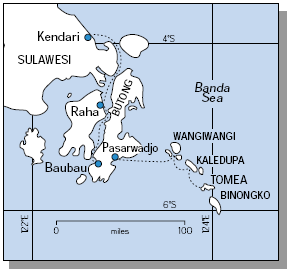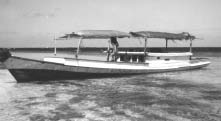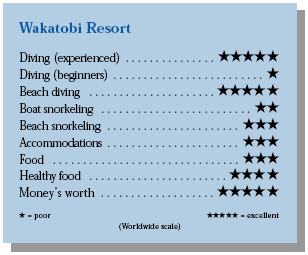Wakatobi in the Tukang BesisContents of this Issue: Recompression Facilities in Palau and Chuuk Editorial Office: Ben Davison Publisher and Editor Undercurrent 3020 Bridgeway, Suite 102 Sausalito, CA 94965 Because it’s there, and because Jacques liked it from the October, 1997 issue of Undercurrent
Dear Fellow Diver, Because sit-down toilets are as rare as Westerners in these parts, each toilet at Wakatobi bears instructions -- illustrated -- on how to lift the lid and how to sit down on it. To this the resort staff adds another important tip: “Always check for sea snakes when you enter the bathroom at night. They like the fresh water in the toilets.” Why would I go deep into Indonesia just to go diving? It was exotic place-names like Wangi Wangi, Bau Bau, and Kaledoupa that got me here -- along with a single sentence in Kal Muller’s Underwater Indonesia, the best source on diving this part of the world: “Perhaps the best diving in the islands remains inaccessible . . . rumored to have moved Jacques Cousteau to declare them the best diving sitei n the world.” Words like these, plus reading about Sulawesi’s wildlife (dog-sized water buffalo, insect-sized primates), were enough to make me max out my credit-card debt. Gaining Access to the Inaccessible Get out a world map. Find Sulawesi, go to the southeast corner, then follow the Tukang Besi island chain out into the Banda Sea, down to the next-to-last island, Tomea. That’s what I did, because that’s what it takes to get there. It also helps to get your mind right, to meditate. During the long trans-Pacific flight to Bali and the lesser hops to Ujang Padang and Kendari, and the four-and-a-halfhour ferry from Kendari, I kept repeating my mantra: “Jacques says it’s the best in the world.” With a variety of ferries to choose from, I chose the new fast ferry -- modern on the outside, third-world airporttype seating on the inside. Carrying 100 passengers, the ferry cruised the scenic, riverlike passage between the islands at 24 knots. Its arrival was obviously a big event at each remote stop; what must have been most of the village came out to stand on the rickety docks and exchange hot roasted corn, fruit, and other goods. When the ferry reached the end of its long run, a guide greeted me at the dock: “Welcome to Bau Bau, the end of the earth.” I had to agree; it was a city that had no hotels until this year and with most of its transportation by becak (a seat with a covered top in front, bicyclists behind). “In the morning,” added my guide, “we will cross the island of Butong to Pasarwadjo and catch another ferry that will take us over the edge of the earth.” “Over the edge” was six more ferry-hours of chanting to the island of Tomea (not even a dock here) and 45 minutes in a small fishing boat to the resort. Long House, Short Swim The resort, newly built in the style of a traditional thatch-roofed long house, sits surrounded by palms on an isolated beach. I settled into one of the six simple, comfortable guest rooms on the second level, and as I ate dinner and lounged beneath the high ceiling of the open porch watching the ancient-looking Bugis ships with their brightly colored sails rounding the point, I had to ask myself, What century is this? Each guest room has twin beds, storage shelves, and a desk. Ceiling fans kept it cool enough during my June visit (air temperatures in the 80s and humidity amazingly low for the tropics); after a couple of days, however, the staff began shutting down the generator at night. I mentioned that the fan not only made it cool, it also kept the mosquitoes at bay. The next day they installed mosquito netting over my windows, thus managing to trap a good number of them in the room (malaria is not a problem here), and the generator was left on all night. I’ll Have the House Reef, Please
Wakatobi Resort is the brainchild of Lorenz Maeder and Erwin Wöber, who conceived the idea while working as dive guides in the Red Sea. Erwin, who had been running the resort by himself with the local staff, was replaced midweek by Lorenz, who had been minding reservations from the Singapore office. Both are Swiss, speak excellent English (also German and French), and are still enthusiastic divers, willing to make an effort to go for the adventure. They chose Wakatobi’s location with great care and for a great reason. In 1992, on the recommendation of the World Wildlife Fund, the Tukang Besi Islands were declared a marine reserve -- and Wakatobi is positioned front row center for this unspoiled show of biodiversity. The show begins as soon as you get wet. The eel grass on the way out and on top of the wall, all in water just a few feet deep, is full of critters, juvenile Picasso triggers, anemone fish, and enough other goodies to satisfy snorkelers. At the end of a buoyed rope, just 100 feet from the resort’s front porch, a canyon cuts into a sheer wall that drops down to a shelf more than 100 feet below and goes far enough in both directions to keep a Wakatobi’s long house–style resort is a comfortable setting. diver occupied for months.
The current along here can change several times in a day. The buoyed rope shows the direction and strength of the current. My checkout dive coincided with one of the wildest currents the resort had ever seen. An upwelling was sending in waves of cold from the depths into the normally 82° F water. I played around in the turbulence, taking my time to check out four crocodile fish, a school of razorfish in a vertical row, a large juvenile batfish outlined in orange, and multiple nudibranchs. The dive staff had asked to see my C-card before the dive, but after my wild ride, nobody demanded proof of underwater skills. The current is slow enough most of the time to dive in either direction. When it does rip, it’s to the south. The resort sits on a point, and there’s another canyon to the south, so you just ride down to the second canyon, get out of the water, and it’s a short walk back to get in and ride it again. I didn’t discover the full beauty of the house wall until the next dive. Bevieosf anthias around the corals create a fairylike atmosphere. Rabbitfish, triggerfish, batfish, sweetlips, lionfish, and many varieties of angel and butterfly fish fill the water along the wall (40 species of butterflyfish have been identified in the region). Color is beyond excellent: orange, red, purple, and bicolor soft corals; large trees of green daisy coral; yellow-black, orange-black, bright yellow, and green crinoids. With time to look, it’s easy to find leaf fish (both yellow and white), an array of tunicates, and nudibranchs. Unfortunately, the ghost pipefish that inspired Wakatobi’s logo have been missing since a recent storm. Beyond the House Reef
The resort’s traditional tarp-covered fishing boat, 30 feet long and powered by a 20-hp inboard (no gears -- just “go” and “don’t go”) is a decent dive boat, thougah little loud and slow. There’s oxygen aboard, but the nearest chamber is in Singapore or Jakarta, at least 24 hours away. Boat dives were twice a day, one in the morning, one in the afternoon (unlimited shore dives). The local boat captain and one-man crew, like the resort staff, did not speak English, but all smiled a lot, were always attentive, and somehow anticipated all our needs. Exit was a backward roll, entrance via a wooden ladder or an easy heave over the low gunwale. Boat-dive briefings told depths and currents, but the choice of how to dive the site was always left up to the divers. Lorenz would dive with us on boat dives and would sometimes accompany us on shore dives for the fun of it. Even with plenty of reef to dive within 20 to 30 minutes of the resort, Lorenz and Erwin were always ready and willing to do a variety of dives that took an hour or more to reach. One such dive was to the Fish Wall, on nearby Binongko. An adventurous, hour-and-a-half boat ride that goes through the surf over the top of a reef makes this a two-tank, picnic-lunch-on-the-island dive. Just a few yards from shore, a vertical wall plunges straight down. As soon as I hit the water, a lone silvertip shark showed up with an entourage of pilotfish, but the real show was along the wall. A thousand pyramid butterfly fish mixed and merged with an endless, swirling school of bannerfish, which was weaving through a flood of fusiliers, blue and gold stripes bright as neon, pouring over the top of the wall. The water was clear, so clear I could look down more than 200 feet into this kaleidoscopic fish funnel, down to where the sunlight was fading; but the multicolored, twisting swarm of fish life went on and on into the deep blue. Another day it was one of many sites that haven’t been named yet: a steep ridge of a reef with 200-foot vis, it was like flying over the Swiss Alps, a feeling shared by an eagle ray as it flew along the canyon. A small whitetip cruised effortlessly with me for a while. Along the ridge top, a display of upright, freezer-sized barrel sponges lined up in a row, each with crinoids in complementary colors of oranges, yellows, and blacks along their tops, communities of fishes in their deeply grooved sides -- breathtaking beauty. A few of the boat dives fell into the “good dive” category: a reef cuttlefish, a six-foot banded sea snake, a new small fish or two to look up -- pleasant diving. Then we’d do a dive that would blow my booties off. On one such dive, my dive buddy, an experienced and well-traveled diver, became so intoxicated with the colors that he knowingly ran out of air. He just didn’t want to come up (he did check to see if I had enough air to share first). The end section of this site, appropriately named Mari Mubuk (“Let’s get drunk”), when the current is running, is the most colorful reef I’ve seen anywhere in the world. In addition to our standard two boat dives a day, on request the boat would take us upcurrent and drop us off, and we would make an hour-and-a-half drift dive back to the resort. The diving was amazing in either direction. To the right of the resort, dropping down past 100 feet will put you at the entrance of a large cavern. The ceiling is covered with two- to three-foot-long soft corals hanging like stalactites. To the left is a world-class-color fish paradise, a soft-coral-city drift dive that I would trade 20 dives in the Caribbean for. A school of sweetlips and a Picasso triggerfish led me along this wall, past the foot-long frogfish, past the crocodile fish, the multiple scorpionfish, the black-and-white and checkered snappers, and past the thousand-and-one varieties of soft corals and hard corals in a hundred different hues, topped off by mixed schools of blue and gold fusiliers, purple anthias, and golden damsels -- an hour and a half of what diving should be. Although most of the dives, both beach and boat, were not strong-current dives or deep dives, the unpredictable nature of these currents should limit this place to experienced divers only. Night diving in front of the resort is excellent (unlimited as well), with flashlight fish and great creature action, but the currents demand respect. On one night dive, a strong current drove me into the wall. It was a wild and wonderful ride, but multiply that hit by all the night divers, and the wall will suffer. The Only Guests, and Loving It It’s hard for me to tell what the resort would be like if it were full. When I arrived, my dive buddy and I were the only guests. A few days later an English gentleman from Oxford showed up, but we certainly never taxed the resort staff. The food was fine, considering our location -- mainly vegetarian, with lots of noodles, rice, and vegetables, sometimes an omelet or rösti (a Swiss potato dish), one night a baked parrotfish, another night drunken chicken (cooked in beer). Dessert was usually a cup of soursop or fresh pineapple. Breakfast could be rice and eggs, French toast, some mornings just coffee, toast, and jam, but if you wanted more, all you had to do was ask. A fridge stocked with soft drinks ($1) and beer ($2) was open around the clock on the honor system. After-dive snacks were gelatin-like desserts, cookies, and such. Nor did we overstress either the dive shop or the dive boat. Two rooms downstairs in the long house, one wet, one dry, served as the dive center. This was thoughtfully organized, with individual plastic crates for our equipment, which staff carried to and from the dive boat. The dry room was for repairs and for housing rental equipment (a good stock of all-new equipment). Aluminum 80s (and one 95 for heavy air users) were topped to a good 3,000 psi from two Bauer compressors in a shed behind the resort. There was no library; bring your own.
Wakatobi has done an outstanding job of making a very remote destination accessible, comfortable, and enjoyable. The diving is impressive. The soft corals rival or surpass Fiji, and visibility is consistently excellent, 90–180 feet more than half of the year. This is the epicenter of biodiversity -- it doesn’t get any better than this. The beach dive in front may lack the turtles of Sipadan’s shore dive, but the color, the soft coral, and the amount of reef to dive far surpass it. It’s the other best beach dive in the world. All of this comes, of course, at a price: it’s hard to get to. Riding the ferries to get there is an adventure, but it takes a long time. Wakatobi’s Singapore office was burdened with pre-trip e-mail from me concerning alternate routes and changing ferry schedules -- it took two days and a lot of effort to get there from Bali. Large creatures are not abundant, though I did see breaching whales and sailfish from the resort and dolphins on the boat rides. The dive boat is a bit uncomfortable on long trips, and there’s no dive platform. It’s a cold-water-only resort, no water at all in your room (bathrooms downstairs). Nondiving activities are limited: a trip to the village on the other side of the island, a walk to the cenote behind the resort, and serving as the center of attention when the locals arrive for their Sunday picnic on the beach. The cliché is “It’s not for everyone.” How would those it’s for explain why they’re willing to pay the price? How would they explain the sense of urgency, the rush to get to a new place before it’s discovered? For these divers (and I’m one of them), it’s the opposite of the mountaineer’s famous answer. It’s because of the fear that it won’t be there, at least in all its unspoiled glory. J. Q. Diver’s Compass: The best way to contact Wakatobi Divers is by e-mail at wakatobi@earthlink.net (the resort has a satellite uplink) or, in Singapore, 011- 65-2355060/7370001, fax 011-65-7384548/7327077. . . . Ferry prices are cheap (around $10), as is the resort itself ($600 for 12-night package that includes diving, accommodations, and meals; $45/day for extensions). I used Island Dreams (800-346-6116 or 713-973-9300) for my air and paid under $1,500 for international and domestic air. The best bargain would be as an add-on to Kungkungan Bay Resort in Manado, with an overnight ferry to Baubau. . . . In Baubau the Sultan’s son has built a new hotel, Ratu Rajawali ($48 a night). Watch for domestic air service to Baubau (there’s an airport now, just no planes); also under consideration is an airport on Kaledupa, a one-hour boat ride from Tomea. . . . A good contrast to Kungkungan’s low-vis, weird-creature muck diving. . . . Change money in Bali, elsewhere is difficult to impossible; no plastic. Tip: If you change money on the street, use your own calculations, as vendors sometimes preset their calculators in their favor. . . . Rooms on the right side of the resort get noise from the compressor (runs while everyone is diving); those on the left get the electrical generator around the clock. Electricity is 220V. . . . No E-6 available. . . . Dive season is May to January, resort is mostly shut down December–April; ideal time is October to mid-November. . . . Island tours around Baubau arranged by P. T. Wolio, phone/fax + 62-0-402-21189. |

I want to get all the stories! Tell me how I can become an Undercurrent Online Member and get online access to all the articles of Undercurrent as well as thousands of first hand reports on dive operations world-wide
| Home | Online Members Area | My Account |
Login
|
Join
|
| Travel Index |
Dive Resort & Liveaboard Reviews
|
Featured Reports
|
Recent
Issues
|
Back Issues
|
|
Dive Gear
Index
|
Health/Safety Index
|
Environment & Misc.
Index
|
Seasonal Planner
|
Blogs
|
Free Articles
|
Book Picks
|
News
|
|
Special Offers
|
RSS
|
FAQ
|
About Us
|
Contact Us
|
Links
|
3020 Bridgeway, Ste 102, Sausalito, Ca 94965
All rights reserved.




 In Essence
In Essence